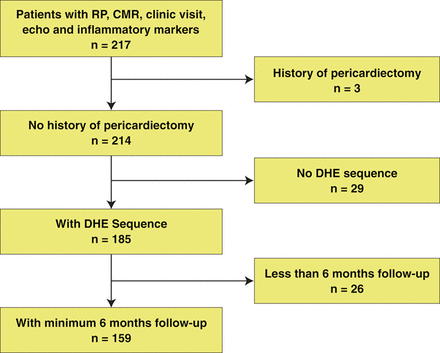JACC: Cardiovascular Imaging ( IF 12.8 ) Pub Date : 2017-11-01 , DOI: 10.1016/j.jcmg.2016.10.020 Arnav Kumar , Kimi Sato , Edlira Yzeiraj , Jorge Betancor , Lin Lin , Balaji K. Tamarappoo , Deborah H. Kwon , Rory Hachamovitch , Allan L. Klein

|
Objectives The aim of this study was to evaluate the prognostic value of quantitative assessment of pericardial delayed hyperenhancement (DHE) among patients with recurrent pericarditis (RP).
Background Pericardial DHE on cardiac magnetic resonance may persist beyond the acute phase of pericarditis, suggesting continued pericardial inflammation.
Methods This is a retrospective cohort study of 159 patients with RP who underwent DHE imaging and had a follow-up period of more than 6 months. Pericardial inflammation was quantified on short-axis DHE sequences by contouring the pericardium, selecting normal septal myocardium as a reference region, and then quantifying the pericardial signal that was >6 SD above the reference. Our primary outcome was clinical remission; secondary outcomes were time to recurrence and recurrence rate.
Results The mean age of our patients was 46 ± 14 years, and 52% were women. During a median follow-up period of 23 months (interquartile range: 15 to 34 months), 32 (20%) patients achieved clinical remission. In the multivariable Cox proportional hazards model, lower quantitative pericardial DHE (hazard ratio: 0.77; 95% confidence interval: 0.64 to 0.93; p = 0.008) was independently associated with clinical remission. When added to background clinical and laboratory variables, quantitative pericardial DHE had incremental prognostic value over baseline clinical and laboratory variables (integrated discrimination improvement: 8%; net reclassification improvement: 36%). Furthermore, patients with a higher quantitative DHE had shorter time to subsequent recurrence (p = 0.012) and had a higher recurrence rate at 6 months (p = 0.026).
Conclusions Quantitative assessment of pericardial DHE was associated with clinical outcomes among patients with RP and provided incremental information regarding the clinical course of patients with RP.
中文翻译:

目的本研究的目的是评估定量评估复发性心包炎(RP)患者心包延迟性高增强(DHE)的预后价值。
背景心包DHE对心脏磁共振的影响可能会持续超过心包炎的急性期,提示持续的心包炎症。
方法这是一项回顾性队列研究,对159例接受DHE成像且随访时间超过6个月的RP患者进行了回顾性研究。通过绘制心包轮廓,选择正常的间隔心肌作为参考区域,然后量化比参考值高6 SD的心包信号,在短轴DHE序列上对心包炎症进行定量。我们的主要结果是临床缓解。次要结果是复发时间和复发率。
结果我们患者的平均年龄为46±14岁,女性为52%。在中位随访期23个月(四分位间距:15到34个月)中,有32位(20%)患者获得了临床缓解。在多变量Cox比例风险模型中,较低的心包定量DHE(风险比:0.77; 95%置信区间:0.64至0.93; p = 0.008)与临床缓解独立相关。当添加到背景临床和实验室变量中时,定量心包DHE的预后价值高于基线临床和实验室变量(综合分辨力改善:8%;净重分类改善:36%)。此外,具有较高定量DHE的患者随后复发的时间较短(p = 0.012),并且在6个月时的复发率较高(p = 0.026)。
结论心包DHE的定量评估与RP患者的临床结局相关,并提供有关RP患者临床过程的增量信息。











































 京公网安备 11010802027423号
京公网安备 11010802027423号